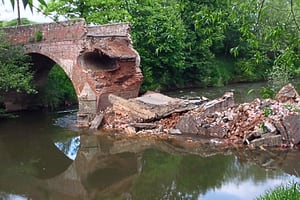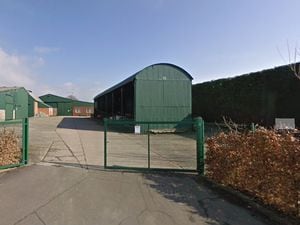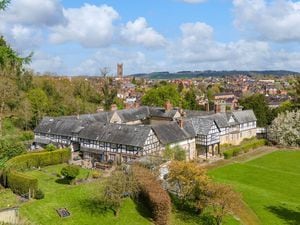Eastham Bridge collapse: Investigations reveal fast-flowing water was likely cause
The dramatic collapse of a historic bridge was likely caused by earth around its foundations being washed away by fast-flowing water, an investigation has revealed.

The findings have been made during the first part of an inquiry into why Eastham Bridge, near Tenbury Wells, suddenly collapsed into the River Teme below on May 24 – just as two school minibuses were about to cross it.
No concerns had been raised over the stability of the Grade-II listed 18th century bridge during a review six months earlier, despite Worcestershire County Council's inspections going "above and beyond", said Councillor Marcus Hart, cabinet member with responsibility for highways.
Specialist independent assessors are still preparing a detailed report on the collapse of the bridge. A meeting on what can be done to replace the structure is expected in the coming weeks.
Councillor Hart said: "Early findings from our detailed investigations into the cause of the collapse of Eastham Bridge are suggesting that the foundations of one of the bridge piers was the victim of scour.
"Scouring occurs due to fast flowing water and can lead to the removal of sediment around bridge piers. We believe that it was scouring that led to the bridge collapsing.
"Our bridge inspection regime goes above and beyond the Government's code of practice. Eastham Bridge was last inspected in December 2015 and Worcestershire County Council wasn't alerted to any concerns about the stability of the bridge.
"We have brought in specialist, independent assessors to look into the incident and we will share their report with the public as soon as we receive it."
Talks have taken place with specialist engineers over a temporary replacement over the summer. But the need for survey work at the site and permissions to build have meant no immediate replacement could be put up directly after the collapse to help residents in Eastham village and the surrounding area facing a 10-mile diversion to get across the river.
Councillor Hart said: "We continue to work closely with our partners at the Environment Agency, Historic England, Natural England and at Malvern Hills District Council.
"The area is designated as a Site of Special Scientific Interest and because of this we have now been told that plans for a temporary bridge will require a full environmental impact assessment to comply with regulations.
"The assessment does mean that the completion date for the construction works will be delayed.
"Due to the time that it takes to complete the assessment we are now looking at whether we can build a permanent, new bridge for local residents, in the same timeframe that it will take to put in place a temporary replacement."





